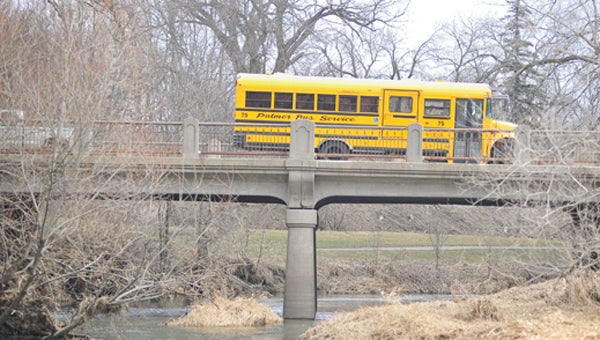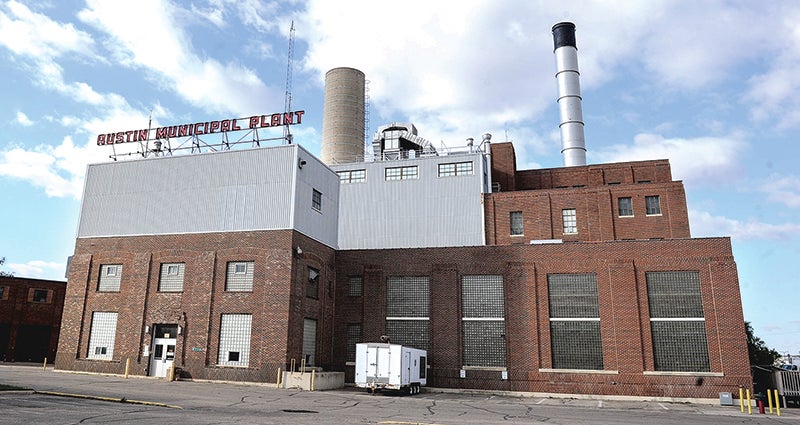Mower bridges a growing concern
Published 10:22 am Monday, April 11, 2011

A bus drives over a bridge on 10th Place Southeast, one of several in Mower County that have been deemed deficient. -- Eric Johnson/photodesk@austindailyherald.com
Funding short for aging bridges
Signs of age are clear on the Oakland Place East bridge over Dobbins Creek.
From East Side Lake, clumps of cement have frayed from the edge of the bridge deck, exposing rebar beneath. On the opposite side, bits of fallen concrete protrude from the water below.
Nearly 4,000 vehicles pass over the bridge daily, and although drivers can’t see the worn concrete, the railing along the bridge’s sidewalks have rusted.
The bridge isn’t deemed dangerous, but it’s a prime example of the nearly 100 deficient bridges in Mower County, and a clear sign these bridges are aging.
“Just because a bridge is structurally deficient, doesn’t mean you can’t drive over it,” County Engineer Mike Hanson said. Instead, the highway department must take additional precautions like load limits to ensure the bridges don’t deteriorate and need to be closed.
Due to decisions made nearly a century ago, the county is struggling to keep pace with the costs and workload of aging bridges, and problem is getting worse.
A Transportation for America study released in March listed Mower County as having the second highest percentage of deficient bridges in the state at 23.5 percent. While the study stated Mower County has 77 deficient structures out of 327, the actual numbers, according to Hanson, are 99 deficient bridges out of a total of 369. That would put Mower County at the highest percentage in the state, at 26.8 percent.
“We’re doing our best job trying to maintain what we have and upgrade what we need to,” Hanson said. “The funding is one of the primary problems.”
Challenges
Funding isn’t the only challenge. Mower County’s Highway Department is one of the few in the state responsible for maintaining most bridges in the county, including those in Austin and townships. In most counties, cities and townships maintain their own bridges. Along with bridges, the county is also responsible for maintaining 405 miles of road and 400 pipes of 48 inches or larger.
“We’ve got a lot of challenges,” Hanson said.
The decision for the county to fund all the bridges in the county came in the early 20th century, when there was a large pot of public money, according to County Coordinator Craig Oscarson. However, the gas tax and other funding sources haven’t kept pace with road and bridge replacements, he said.
Commissioner Ray Tucker said the arrangement makes keeping up with repairs difficult.
“Its a pretty big, mammoth undertaking,” Tucker said. “As funding becomes available, we try to catch up.”
Since most bridge repair money comes from state funds, Oscarson said it’s difficult to secure additional funding. Hanson said the little amount of federal funding is highly competitive. One way to get more money would be to increase local property taxes, which is not being discussed.
However, the challenges of bridge repairs are nothing new.
“It didn’t come as a surprise,” Oscarson said of the report. “We’ve had this issue for 20 years or better.”
Costs
In 2011, the county has budgeted about $1.3 million for bridge repairs.
From 1998 to 2010, Hanson estimated the highway department spent more than $1 million a year maintaining bridges. However, most of the money spent on bridge repairs and replacements comes from state funds – including the gas tax – that are divvied out by the state each year.
While Hanson described federal funding as sparse, the county has spent about $2.5 million of local reserve funds since 1998.
With budget cuts and other restrictions, Oscarson said the pot for public infrastructure has been limited.
“There’s not enough money in the system right now to keep our roads and bridges up to a level that’s needed by the public,” Oscarson said.
Transportation for America Minnesota Field Organizer Andrea Kiepe said her organization is looking to help secure federal funding to assist financially strapped states, counties and cities. Transportation for America is working to promote a national transpiration bill that Kiepe said she hopes will be passed in the next six months.
“A lot of the difficulty is that there are people – like your county engineer – who would love to be addressing this more rapidly than they’re able to now, but they don’t have the funds, the manpower,” Kiepe said.
“If we get more federal funding that will help the states, and it may allow them to have more flexibility,” she said. “This is a need; this is not a desire.”
Safe bridges
While Minnesota didn’t top the national rankings, Kiepe said bridge repairs are a significant issue in Minnesota because of the high number of bridges, largely due to its typography.
Another question is how to distribute the available money. The metro area garnered much of the attention after the Interstate 35W bridge collapse and because metro bridges are more widely traveled. However, Kiepe said there’s still a need in rural areas.
“The bottom line is everyone in the state deserves safe bridges,” she said.
The County’s plan
The county has a plan to replace about six bridges each year. Oscarson said the county analyzes the condition of bridges and then ranks and prioritizes them from best to worst. However, the repairs also depend on what roads are scheduled for replacements, Oscarson said.
“A lot of it depends on the funding that’s available,” he said.
With the county only able to replace a small number of deficient bridges each year, Oscarson said it’s difficult to stay caught up as more bridges age.
“It’s an endless cycle,” he said.
Of the county’s 99 deficient bridges, Hanson said 76 were constructed between 1915 and 1941.
The remaining 23 deficient bridges were built between 1941 and 1989, but most were constructed with timber pile substructures or corrugated steel pipes that have a limited life, according to Hanson.
He said it can cost almost as much to rehabilitate a timber substructure as it does to replace the entire bridge.
According to Hanson, structurally deficient bridges can still be used, but they must be monitored and load limits are often enforced. In extreme cases, a bridge may be closed.
Oscarson said no bridges are currently in danger of being shut down for safety reasons, but he noted bridges have been closed near Taopi and Adams. While the bridges weren’t highly traveled, he said farmers were concerned because they had to drive an extra five to 10 miles in some cases during harvest and planting seasons.
“If money doesn’t keep up … we don’t want to see that happen,” Oscarson said.
Inspections
The crumbling concrete on the edges of the 79-year-old Oakland Place Southeast bridge crossing Dobbins Creek is a clear sign of age. However, Hanson and other county leaders assure the bridges are safe to traffic.
“We inspect them annually,” Hanson said.
Along with yearly inspections, Hanson said load limits are set to prevent the structures from deteriorating faster.
Three bridges in Nevada, Sargeant and LeRoy townships are already scheduled to be replaced this year. Preliminary discussion has begun about restoring the 78-year-old Roosevelt Bridge. However, in order to restore and maintain the bridge’s historic nature, the county needs approval from the state and the Minnesota Historical Society.
Hanson said to stay tuned as additional bridge projects could go before the board soon.




